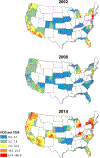Urban-rural variation in the socioeconomic determinants of opioid overdose
- PMID: 30592998
- PMCID: PMC6375680
- DOI: 10.1016/j.drugalcdep.2018.11.024
Urban-rural variation in the socioeconomic determinants of opioid overdose
Abstract
Background: Prescription opioid overdose (POD) and heroin overdose (HOD) rates have quadrupled since 1999. Community-level socioeconomic characteristics are associated with opioid overdoses, but whether this varies by urbanicity is unknown.
Methods: In this serial cross-sectional study of zip codes in 17 states, 2002-2014 (n = 145,241 space-time units), we used hierarchical Bayesian Poisson space-time models to analyze the association between zip code-level socioeconomic features (poverty, unemployment, educational attainment, and income) and counts of POD or HOD hospital discharges. We tested multiplicative interactions between each socioeconomic feature and zip code urbanicity measured with Rural-Urban Commuting Area codes.
Results: Percent in poverty and of adults with ≤ high school education were associated with higher POD rates (Rate Ratio [RR], 5% poverty: 1.07 [95% credible interval: 1.06-1.07]; 5% low education: 1.02 [1.02-1.03]), while median household income was associated with lower rates (RR, $10,000: 0.88 [0.87-0.89]). Urbanicity modified the association between socioeconomic features and HOD. Poverty and unemployment were associated with increased HOD in metropolitan areas (RR, 5% poverty: 1.12 [1.11-1.13]; 5% unemployment: 1.04 [1.02-1.05]), and median household income was associated with decreased HOD (RR, $10,000: 0.88 [0.87-0.90]). In rural areas, low educational attainment alone was associated with HOD (RR, 5%: 1.09 [1.02-1.16]).
Conclusions: Regardless of urbanicity, elevated rates of POD were found in more economically disadvantaged zip codes. Economic disadvantage played a larger role in HOD in urban than rural areas, suggesting rural HOD rates may have alternative drivers. Identifying social determinants of opioid overdoses is particularly important for creating effective population-level interventions.
Keywords: Heroin; Opioid-related disorders; Prescription drug misuse; Rural health; Socioeconomic factors; Urban health.
Copyright © 2018 Elsevier B.V. All rights reserved.
Conflict of interest statement
No conflict declared.
Figures
References
-
- Agency for Healthcare Research and Quality, 2018. Introduction to the HCUP State Inpatient Databases. Agency for Healthcare Research and Quality, Rockville, MD.
-
- Aguero-Valverde J, Jovanis PP, 2006. Spatial analysis of fatal and injury crashes in Pennsylvania. Accid. Anal. Prev 38, 618–625. - PubMed
-
- Altschuler A, Somkin CP, Adler NE, 2004. Local services and amenities, neighborhood social capital, and health. Soc. Sci. Med 59, 1219–1229. - PubMed
-
- Boardman JD, Finch BK, Ellison CG, Williams DR, Jackson JS, 2001. Neighborhood disadvantage, stress, and drug use among adults. J. Health Soc. Behav 42, 151–165. - PubMed



